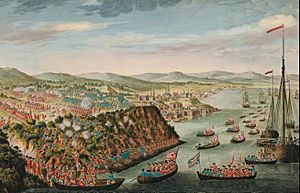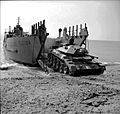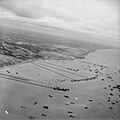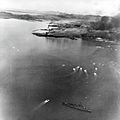Amphibious warfare facts for kids

Amphibious warfare is a special type of military operation. It involves using ships to move soldiers, vehicles, and equipment from the sea onto a coastline that might be dangerous. Imagine a large army needing to land on an enemy's beach – that's amphibious warfare!
Historically, soldiers used regular boats from their ships to get to shore. But after the Gallipoli Campaign in World War I, special boats were invented. These "landing craft" were designed just for getting troops and heavy gear like tanks onto beaches. Today, fast patrol boats, inflatable boats, and even mini-submarines are used for special forces.
The word "amphibious" became popular in the 1930s. It described new vehicles like tanks that could move both on land and in water.
What is Amphibious Warfare?
Amphibious warfare covers many different kinds of operations. These operations are defined by their goal, size, and how they are carried out. In the British Empire, these were called "combined operations." This meant that naval (sea), military (land), and air forces all worked together. They had their own commanders but shared one big goal. All armed forces that train soldiers for landings from ships agree with this idea.
Since the 1900s, landing troops on a beach has been seen as one of the most difficult military actions. It needs many different military skills to work perfectly together.
Working Together is Key
For a successful amphibious landing, many parts of the military must coordinate. This includes:
- Air power: Airplanes and helicopters help protect the landing and attack enemy positions.
- Naval gunfire: Warships use their big guns to clear the way on shore.
- Naval transport: Special ships carry soldiers and equipment across the water.
- Logistics: This is the careful planning of how to get supplies, food, and everything else needed to the right place at the right time.
- Special equipment: Landing craft, amphibious vehicles, and other unique tools are essential.
- Land warfare: Soldiers on the ground need to know how to fight once they land.
- Tactics: These are the specific plans and methods used to achieve the mission.
- Training: Everyone involved needs lots of practice to make sure the complex operation goes smoothly.
Images for kids
-
The Bayeux Tapestry depicts the 1066 Norman invasion of England with a force of some 8,000 infantry and heavy cavalry landed on the English shore.
-
British and American movements during the Chesapeake Campaign
-
Ships of the North Atlantic Blockading Squadron bombarding Fort Fisher prior to the ground assault, during the American Civil War
-
German battleship Grosser Kurfürst during Operation Albion in October 1917
-
V Beach about two days after the landing, seen from the bow of the River Clyde
-
Anzac Beach amphibious landing, on April 25, 1915
-
The Landing Craft Mechanized was designed by Inter-Service Training and Development Centre from 1938 as the first specialized amphibious ship for the transportation of tanks.
-
Major Earl Hancock Ellis developed amphibious warfare doctrine for the United States Marine Corps in the interwar period, and successfully predicted the nature of the subsequent Pacific campaign.
-
LCVPs, known as 'Higgins Boats', were the first specialized landing craft for the US Navy. Pictured, USS Darke LCVP 18, possibly with Army troops as reinforcements at Okinawa, 1945.
-
Canadian landings at Juno Beach in the Landing Craft Assault
-
USS LCI-326, a Landing Craft Infantry, during training for D-Day
-
Two examples of the LCM 1 on an exercise prior to the 1942 Dieppe Raid. On the right is an earlier model without the later fully armoured steering shelter. This craft also has been given additional armour around the tank well and a ramp extension.
-
A Canadian LST off-loads an M4 Sherman during the Allied invasion of Sicily in 1943.
-
A large landing craft convoy crosses the English Channel on 6 June 1944.
-
PLUTO Pump from Sandown on the Isle of Wight
-
Landing craft approach Blue Beach during the Inchon landings on 15 September 1950, covered by the U.S. Navy destroyer USS De Haven (DD-727) (bottom center).
See also
 In Spanish: Guerra anfibia para niños
In Spanish: Guerra anfibia para niños




























